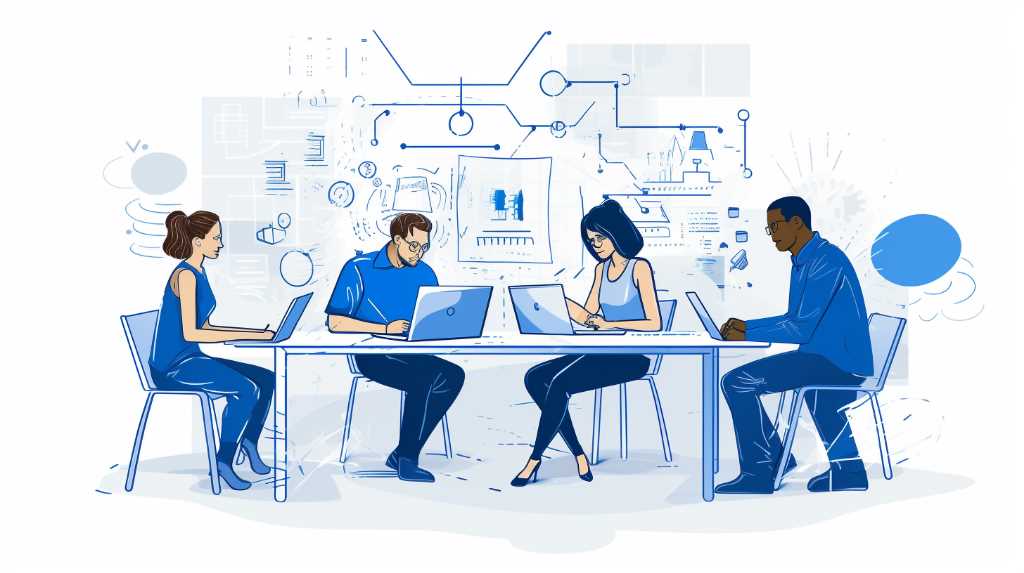In this article, we will explore the importance of client feedback and how collaborative approaches in client feedback workshops can lead to successful web designs. Discover the best practices for conducting these workshops and effective communication strategies for seamless iterations.
Empower your clients through collaborative design feedback and learn about the tools and techniques that can facilitate these workshops. Overcome challenges and find inspiration in real-life case studies.
Let's dive into the world of client feedback workshops and transform your web design process.
Key Takeaways
- Client feedback and collaboration are crucial in web design iterations.
- Real-time collaboration and effective communication lead to successful outcomes.
- Strategies and techniques, such as clear communication channels and user research, can be used to conduct client feedback workshops.
- Overcoming challenges, such as lack of face-to-face interaction and miscommunication, can be addressed through video conferencing tools and clear communication channels.
Importance of Client Feedback in Web Design Iterations
Client feedback is crucial in web design iterations because it allows for continuous improvement and aligns the project with your vision. By incorporating user input throughout the design process, you can ensure that the final product meets your needs and expectations.
One of the main benefits of iterative design is that it allows for constant refinement. Through regular feedback sessions, you have the opportunity to review and make adjustments to the design based on your preferences and requirements. This iterative approach ensures that the final website reflects your vision and goals.
Incorporating user input is another key aspect of client feedback in web design iterations. By involving users in the design process, you can gather valuable insights and perspectives. This input helps you understand how users will interact with the website and identify any usability issues early on. By incorporating user feedback, you can create a website that is intuitive, user-friendly, and meets the needs of your target audience.
Overall, client feedback plays a vital role in web design iterations. It allows for continuous improvement, ensures alignment with your vision, and helps create a website that is tailored to your needs and the needs of your users. By actively participating in the design process and providing regular feedback, you can contribute to the success of your web project.
Key Elements of Collaborative Approaches in Client Feedback Workshops
In this section, you will explore the key points of real-time collaboration in client feedback workshops. Real-time collaboration offers numerous benefits, including increased efficiency and the ability to address issues immediately.
It also facilitates effective communication, allowing for clear and timely exchange of ideas between the designer and the client. Additionally, emphasizing client involvement throughout the process ensures that their feedback is valued and incorporated into the design iterations.

Benefits of Real-Time Collaboration
You'll love the benefits of real-time collaboration during web design iterations. When working collaboratively, you have the advantage of receiving immediate feedback and making necessary adjustments in real time. This allows for a more efficient and streamlined design process.
With real-time collaboration, you can easily communicate and brainstorm ideas with your team or clients, ensuring that everyone is on the same page and working towards a common goal. Additionally, real-time collaboration enables you to address any concerns or issues promptly, preventing any potential delays or misunderstandings.
By actively involving all stakeholders in the design process, you can create a more user-centered and effective end product. Overall, the benefits of real-time collaboration in web design iterations are undeniable and can greatly enhance the quality and success of your projects.
Facilitating Effective Communication
When working together, it's important to actively engage and communicate with your team to ensure effective collaboration and successful outcomes. Improving clarity and managing expectations are crucial aspects of facilitating effective communication.
By clearly expressing your ideas and actively listening to others, you can enhance the clarity of your team's communication. This can be achieved by using concise and direct language, avoiding jargon or technical terms that may confuse others.
Additionally, managing expectations is vital to ensure that everyone is on the same page and working towards common goals. Clearly communicating project timelines, deliverables, and responsibilities can help avoid misunderstandings and promote a more productive working environment.
Regular check-ins and updates can further enhance communication and provide opportunities for clarification and adjustment if necessary. By actively engaging and communicating with your team, you can foster a collaborative environment that leads to successful outcomes.
Emphasizing Client Involvement
To ensure successful outcomes, actively involve your clients throughout the process by regularly seeking their input and involving them in decision-making. Client participation is crucial in collaborative decision making when it comes to web design iterations. By including your clients in the decision-making process, you not only gain valuable insights and perspectives but also build a stronger relationship with them.
This collaborative approach allows clients to feel heard and valued, which ultimately leads to a more successful project. Regularly seeking their input ensures that their needs and preferences are considered, resulting in a final product that meets their expectations.
Additionally, involving clients in decision-making empowers them to take ownership of the project and feel invested in its success. By fostering client participation and collaborative decision making, you create a positive and productive working environment that leads to better outcomes.

Best Practices for Conducting Client Feedback Workshops
One of the best practices for conducting client feedback workshops is ensuring clear communication channels between the design team and the client. When it comes to remote collaboration, it becomes even more crucial to establish effective communication methods.
By incorporating user insights into the design process, you can create a more user-centered website that meets the needs and expectations of your target audience. To facilitate remote collaboration, consider using online project management tools that allow real-time communication and file sharing. Platforms like Slack or Trello can help streamline communication between the design team and the client, ensuring everyone is on the same page throughout the feedback process.
Another best practice is to schedule regular video conferences or virtual meetings to discuss design iterations. This allows for face-to-face interactions, making it easier to convey feedback and address any concerns or questions. Additionally, using screen sharing during these meetings can help the client visualize the proposed changes and provide more accurate feedback.
Furthermore, it's essential to incorporate user insights into the design process. Conduct user research to gather valuable feedback and understand how users interact with the website. This feedback can help drive the design decisions and ensure the final product is user-friendly and meets their needs.
Effective Communication Strategies for Web Design Iterations
In the previous subtopic, you learned about the best practices for conducting client feedback workshops. Now, let's delve into the effective communication strategies for web design iterations. Effective communication plays a vital role in ensuring a successful web design project. By utilizing the right communication tools and feedback techniques, you can enhance collaboration and streamline the design process.
Firstly, using digital communication tools such as project management software, video conferencing platforms, and messaging apps can facilitate real-time communication between you and your clients. These tools allow for quick updates, file sharing, and seamless communication, eliminating the need for lengthy email chains.
Secondly, implementing feedback techniques like active listening and constructive criticism can foster a productive dialogue between you and your clients. Actively listening to their concerns and ideas shows that you value their input and are committed to meeting their needs. Additionally, providing constructive criticism in a respectful manner helps clients understand the design decisions and encourages them to provide more meaningful feedback.
Empowering Clients Through Collaborative Design Feedback
When it comes to web design, involving clients in the process can bring numerous benefits. By actively engaging clients, you can ensure that their needs and preferences are incorporated into the final product, leading to higher satisfaction and better outcomes.
To make this collaboration successful, it is essential to employ effective feedback strategies that promote open communication and facilitate a constructive exchange of ideas.
Client Involvement Benefits
Clients' involvement during the web design iterations brings numerous benefits to the project. By actively participating in the process, you can ensure that your vision and goals are effectively communicated to the design team. This level of engagement allows for better collaboration and understanding between you and the designers, resulting in a website that truly represents your brand and meets your expectations.

One of the key benefits of client participation is the increased satisfaction you will experience with the final product. By being involved in the design iterations, you have the opportunity to provide feedback and make suggestions along the way. This ensures that any concerns or changes you may have are addressed in a timely manner, leading to a website that aligns perfectly with your needs.
Additionally, your involvement allows you to have a sense of ownership over the project. By actively participating and providing input, you become a valuable contributor to the design process. This not only enhances your satisfaction but also encourages a greater sense of pride in the final result.
Overall, client participation during web design iterations brings a multitude of benefits, from increased satisfaction to a stronger sense of ownership. By actively engaging with the design team, you can ensure that your vision is accurately translated into a website that meets your expectations and represents your brand effectively.
Effective Feedback Strategies
To provide effective feedback, you can actively participate in workshops and use collaborative approaches. By engaging in these activities, you contribute to the success of the project and ensure that your feedback is valuable and actionable.
During workshops, you have the opportunity to share your thoughts and ideas with the design team, allowing for a more collaborative design process. This enables you to provide feedback in real-time and make immediate adjustments, leading to a more efficient and effective outcome.
Additionally, collaborative approaches foster open communication and build trust between you and the design team, creating a positive working relationship. By actively participating and utilizing these effective feedback techniques in the collaborative design process, you can help shape the final product and ensure that your vision is realized.
Tools and Techniques for Facilitating Client Feedback Workshops
You can use various tools and techniques to facilitate client feedback workshops for web design iterations. One of the most commonly used tools is a prototyping software like Adobe XD or InVision. These tools allow you to create interactive prototypes that clients can easily navigate and provide feedback on. By using these tools, you can gather valuable insights on the user experience and make necessary design changes.
Another effective technique is the use of collaborative whiteboarding sessions. Platforms like Mural or Miro enable real-time collaboration, where clients and designers can brainstorm ideas, sketch wireframes, and provide feedback together. This not only enhances communication but also fosters a sense of collaboration and ownership in the design process.
In addition, conducting usability testing sessions can be a valuable technique to gather client feedback. Tools like UserTesting or Hotjar provide remote testing capabilities, allowing clients to observe users interacting with their website in real-time. This firsthand feedback can help identify usability issues and inform design decisions.
Lastly, incorporating feedback surveys or questionnaires can be an efficient way to gather client input. Tools like Google Forms or Typeform allow you to create customized surveys and collect feedback in an organized manner.

Overcoming Challenges in Collaborative Web Design Iterations
Overcoming challenges in collaborative web design iterations can be achieved by implementing effective communication strategies and fostering a sense of teamwork among all stakeholders. When it comes to remote collaboration, there are unique challenges that can arise. However, with the right strategies for remote feedback sessions, you can ensure a smooth and productive design process.
One challenge in remote collaboration is the lack of face-to-face interaction. Without being in the same physical space, it can be difficult to convey ideas and provide feedback effectively. To overcome this challenge, it is important to utilize video conferencing tools that allow for real-time communication. This way, you can see and hear each other, facilitating a more personal and engaging collaboration experience.
Another challenge is the potential for miscommunication. In remote settings, it is easier for messages to be misinterpreted or misunderstood. To address this, it is crucial to establish clear and concise communication channels. Utilize project management tools that allow for easy sharing of design files and documents. Additionally, encourage regular check-ins and clarify expectations to ensure everyone is on the same page.
Lastly, fostering a sense of teamwork is essential for successful remote collaboration. Encourage open and honest communication, where all stakeholders feel comfortable expressing their opinions and ideas. Foster a collaborative environment where everyone's input is valued. Regularly schedule team meetings and provide opportunities for brainstorming and ideation sessions.
Case Studies: Successful Implementation of Client Feedback Workshops
Implementing effective communication strategies and fostering teamwork have been key factors in the successful implementation of client feedback workshops in real-world case studies. These workshops have proven to be a valuable tool in empowering clients and ensuring their satisfaction with the final product.
In these successful case studies, the workshops have provided a platform for open and transparent communication between the clients and the design team. By actively involving clients in the design process, they feel empowered and have a sense of ownership over the project. This collaborative approach allows clients to provide valuable feedback and insights, which ultimately leads to a more tailored and satisfactory end result.
Furthermore, the workshops foster teamwork between the design team and the clients. By creating an environment of trust and collaboration, both parties are able to work together towards a common goal. The design team benefits from the clients' expertise and perspective, while the clients benefit from the design team's knowledge and skills. This symbiotic relationship ensures that the final product meets the clients' needs and expectations.
Continuous Improvement: Iterative Approaches to Web Design Based on Client Feedback
To continuously improve your web design, it's important to incorporate iterative approaches that are based on the valuable insights and suggestions provided by your clients. By embracing continuous improvement, you can ensure that your website evolves and adapts to meet the changing needs and preferences of your target audience.
One effective way to achieve continuous improvement is by using iterative approaches in your web design process. This involves breaking down the design and development into smaller, manageable tasks that can be completed and tested in short cycles. By doing so, you can gather feedback from your clients and make necessary adjustments along the way.
Iterative approaches allow you to refine and enhance your web design based on the input you receive from your clients. This feedback is invaluable as it provides you with real-world insights and allows you to identify areas for improvement. By incorporating these suggestions into your design iterations, you can create a website that not only meets your clients' expectations but also exceeds them.

In addition to client feedback, it's also crucial to stay up to date with the latest design trends and best practices. By continuously learning and experimenting with new techniques, you can ensure that your web design remains fresh and relevant. This constant pursuit of improvement will help you stay ahead of the competition and deliver exceptional results for your clients.
Frequently Asked Questions
What Are Some Common Challenges Faced by Web Designers When Incorporating Client Feedback Into Iterations?
When incorporating client feedback into web design iterations, challenges often arise. However, there are strategies you can use to overcome these obstacles and ensure a successful collaboration with your clients.
How Can Web Designers Effectively Communicate Their Design Decisions to Clients During the Feedback Process?
To effectively communicate your design decisions during the feedback process, be clear and concise. Use visual aids, explain the reasoning behind your choices, and actively listen to the client's concerns to ensure mutual understanding and collaboration.
Are There Any Specific Tools or Techniques That Can Make Client Feedback Workshops More Efficient and Productive?
To make client feedback workshops more efficient and productive, use efficient tools and productive techniques. These can help streamline the process, improve communication, and ensure that everyone is on the same page.
Can You Provide Examples of Successful Case Studies Where Client Feedback Workshops Have Significantly Improved Web Design Iterations?
You can find successful case studies where client feedback workshops significantly improved web design iterations. These case studies demonstrate effective communication of design decisions to clients during the feedback process.
How Can Web Designers Ensure a Continuous Improvement Process Based on Client Feedback in Their Web Design Projects?
To ensure a continuous improvement process in your web design projects, actively collaborate with clients for valuable feedback. Utilize client collaboration to identify areas of improvement and make iterative changes that enhance the design and user experience.
Conclusion
You've learned about the importance of client feedback in web design iterations and how collaborative approaches in client feedback workshops can enhance the design process. By following best practices and utilizing effective communication strategies, you can empower clients and create a successful feedback loop.
Tools and techniques for facilitating these workshops are readily available, and overcoming challenges is possible with the right mindset. Through case studies, you've seen the positive impact of client feedback workshops. Remember, continuous improvement is key in web design, and client feedback should always be valued and integrated into future iterations.

